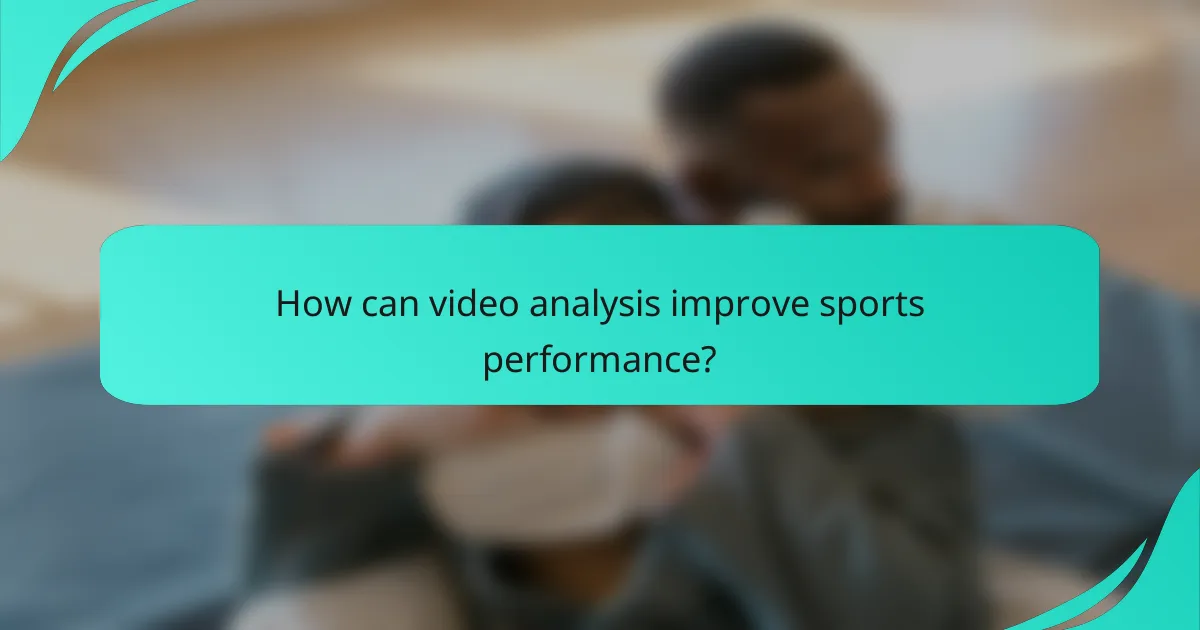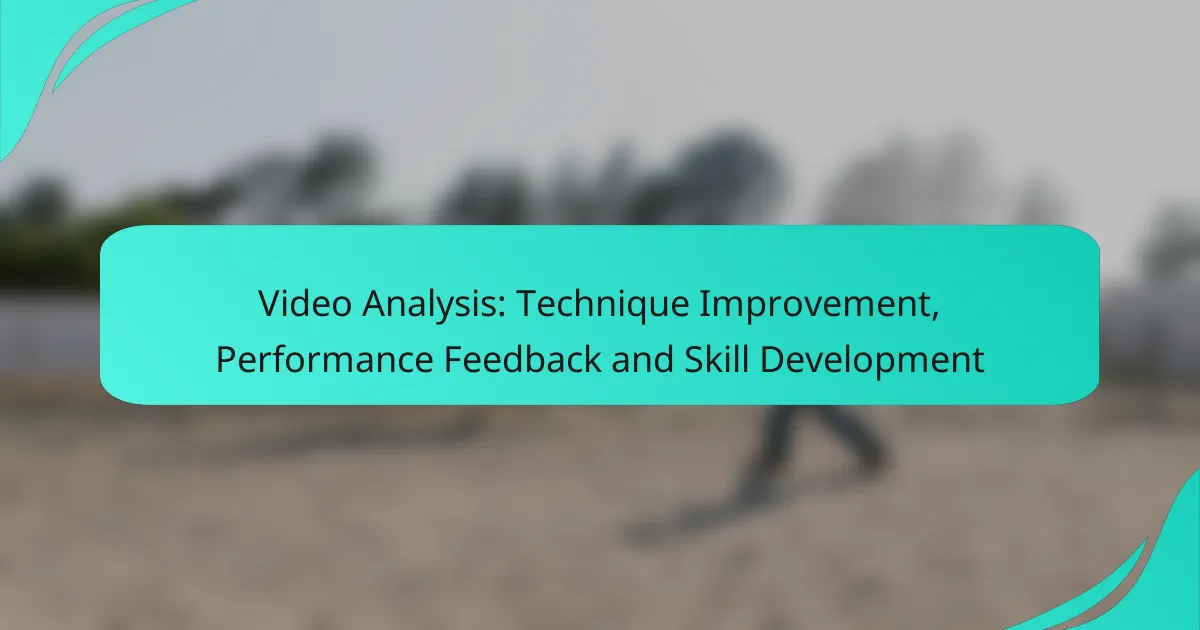Video analysis is a powerful tool for athletes seeking to improve their performance through visual feedback on techniques and strategies. By allowing for detailed evaluations, this method facilitates targeted skill development and enhances overall training outcomes. Athletes can identify strengths and weaknesses, enabling them to make informed adjustments and track their progress effectively.

How can video analysis improve sports performance?
Video analysis enhances sports performance by providing athletes with visual feedback on their techniques and strategies. This method allows for precise evaluations and targeted improvements, leading to better overall results in training and competition.
Enhanced technique evaluation
Video analysis allows athletes to closely examine their techniques, identifying strengths and weaknesses that may not be apparent during practice. By reviewing footage, athletes can observe their movements frame by frame, enabling them to refine their skills effectively.
For instance, a swimmer can analyze their stroke mechanics to improve efficiency and reduce drag. This detailed evaluation can lead to significant performance gains, often translating into faster times and improved scores.
Real-time feedback mechanisms
Integrating video analysis with real-time feedback tools can enhance an athlete’s training experience. Coaches can provide immediate corrections during practice, allowing athletes to make adjustments on the spot.
Using mobile apps or wearable technology, athletes can receive instant notifications about their performance metrics, such as speed or technique flaws. This immediate feedback loop fosters quicker learning and adaptation, which is crucial in high-stakes environments.
Data-driven performance insights
Video analysis generates valuable data that can inform training decisions and strategies. By tracking performance trends over time, athletes and coaches can identify patterns that indicate areas for improvement.
For example, a basketball player might analyze shooting angles and success rates from different court positions. This data can guide targeted drills, helping to increase shooting accuracy and overall scoring efficiency.
Comparison with professional standards
Video analysis enables athletes to benchmark their performance against professional standards. By comparing their techniques and results with those of elite athletes, they can gain insights into what it takes to reach the next level.
Coaches can use side-by-side video comparisons to highlight differences in technique, strategy, and execution. This method not only motivates athletes but also provides clear goals for improvement, making the path to excellence more tangible.

What are the best video analysis tools for athletes?
The best video analysis tools for athletes enhance performance by providing detailed feedback on techniques and skills. These tools vary by application, catering to team sports, individual coaching, and mobile analysis needs.
Hudl for team sports
Hudl is a comprehensive video analysis platform designed specifically for team sports like football, basketball, and soccer. It allows coaches to upload game footage, tag plays, and create highlight reels, facilitating strategic discussions and player development.
One of Hudl’s key features is its ability to provide performance metrics and insights, helping teams identify strengths and weaknesses. Coaches can share videos with players for personalized feedback, which is crucial for improving teamwork and individual skills.
Ubersense for individual coaching
Ubersense is tailored for individual athletes and coaches, focusing on technique improvement through detailed video analysis. Users can record their performances, annotate videos, and compare them against professional standards or peers.
This tool is particularly useful for sports like gymnastics, swimming, and tennis, where technique is vital. Ubersense allows for slow-motion playback and frame-by-frame analysis, enabling athletes to make precise adjustments to their form.
Coach’s Eye for mobile analysis
Coach’s Eye is a mobile application that provides on-the-go video analysis for coaches and athletes. It allows users to record, review, and analyze performances directly from their smartphones or tablets, making it convenient for training sessions and competitions.
With features like slow-motion playback and drawing tools, Coach’s Eye helps athletes visualize their movements and understand areas for improvement. This app is ideal for sports that require quick feedback, such as track and field or martial arts, allowing for immediate corrections during practice.

How does video analysis facilitate skill development?
Video analysis enhances skill development by providing visual feedback that identifies strengths and weaknesses in performance. By reviewing recorded sessions, athletes and learners can pinpoint specific areas for improvement and track their progress over time.
Targeted skill drills
Video analysis allows for the design of targeted skill drills that focus on specific techniques or movements. For instance, a basketball player can analyze their shooting form and then practice drills that emphasize correcting their stance or follow-through. This focused approach leads to more efficient skill acquisition.
When creating drills, consider the key aspects of the skill being developed. Break down complex movements into manageable parts, and use video feedback to assess improvement after each practice session.
Progress tracking over time
Tracking progress through video analysis provides a clear visual representation of skill development over time. Athletes can compare their current performance to previous recordings, allowing them to see tangible improvements or identify persistent issues. This method fosters motivation and accountability.
To effectively track progress, set specific goals and regularly record sessions. Use a consistent format for analysis, such as noting key performance indicators, to make comparisons meaningful and actionable.
Personalized coaching strategies
Video analysis supports personalized coaching strategies by enabling coaches to tailor feedback based on individual performance. By reviewing footage together, coaches can highlight specific areas for improvement and suggest customized drills that align with the athlete’s unique needs.
When implementing personalized strategies, ensure that feedback is constructive and actionable. Encourage open communication between the coach and athlete, allowing for adjustments in training plans based on the insights gained from video analysis.

What are the prerequisites for effective video analysis?
Effective video analysis requires a solid understanding of both video technology and performance metrics. These foundational elements enable accurate assessment and improvement of techniques, ultimately enhancing skill development.
Understanding basic video technology
Familiarity with video technology is essential for effective analysis. This includes knowledge of camera types, resolution, frame rates, and editing software. For instance, using a camera with at least 60 frames per second can capture motion more smoothly, making it easier to analyze techniques.
Additionally, understanding how to use video editing tools can help highlight key moments in performance. Simple edits, such as slow-motion playback or zooming in on specific actions, can provide clearer insights into areas needing improvement.
Familiarity with performance metrics
Knowing relevant performance metrics is crucial for evaluating skills accurately. Metrics can include speed, accuracy, and consistency, depending on the sport or activity. For example, in swimming, tracking lap times and stroke counts can reveal trends in performance over time.
Establishing benchmarks based on these metrics allows for meaningful comparisons. Athletes can set personal goals and measure progress against established standards, which can motivate continuous improvement. Regularly reviewing these metrics helps identify strengths and weaknesses, guiding targeted training efforts.

How can coaches leverage video analysis for feedback?
Coaches can utilize video analysis to provide targeted feedback that enhances athlete performance and skill development. By reviewing recorded sessions, coaches can identify strengths and weaknesses, allowing for more effective training strategies tailored to individual needs.
Structured feedback sessions
Structured feedback sessions involve systematically reviewing video footage with athletes to highlight key performance aspects. Coaches should prepare specific clips that illustrate both successful techniques and areas needing improvement. This focused approach helps athletes understand their performance in context and fosters a constructive dialogue.
During these sessions, it’s beneficial to establish a consistent format, such as starting with positive feedback before addressing areas for growth. This method encourages a positive atmosphere and motivates athletes to engage with the feedback actively.
Incorporating athlete input
Incorporating athlete input into video analysis enhances the feedback process by making it a collaborative effort. Coaches should encourage athletes to share their perspectives on their performance, which can lead to deeper insights and a greater sense of ownership over their development.
To facilitate this, coaches can ask open-ended questions about specific plays or techniques, prompting athletes to reflect on their decisions and actions. This practice not only builds critical thinking skills but also helps athletes feel valued and understood in their training environment.

What are the challenges of implementing video analysis?
Implementing video analysis can be hindered by various challenges, including technical difficulties and time constraints. These obstacles can affect the effectiveness and efficiency of the analysis process, making it essential to address them proactively.
Technical difficulties
Technical difficulties often arise from inadequate equipment or software compatibility issues. For instance, using outdated cameras may result in poor video quality, making analysis less effective. It’s crucial to ensure that all devices used for recording and analyzing video are up-to-date and compatible with the analysis software.
Additionally, users may encounter problems with video editing tools or data storage. Familiarizing oneself with the software and ensuring sufficient storage space can mitigate these challenges. Regular updates and maintenance of hardware and software can also help prevent technical setbacks.
Time constraints for analysis
Time constraints can significantly impact the ability to conduct thorough video analysis. Coaches and athletes often have limited time to review footage, which can lead to rushed assessments and missed insights. Allocating specific time slots for analysis can help ensure that this critical process is not overlooked.
To maximize efficiency, consider prioritizing key moments in the footage that are most relevant to performance improvement. Setting clear objectives for each analysis session can help focus efforts and make the best use of available time. Using streamlined software that allows for quick editing and feedback can also save valuable time during the analysis process.
